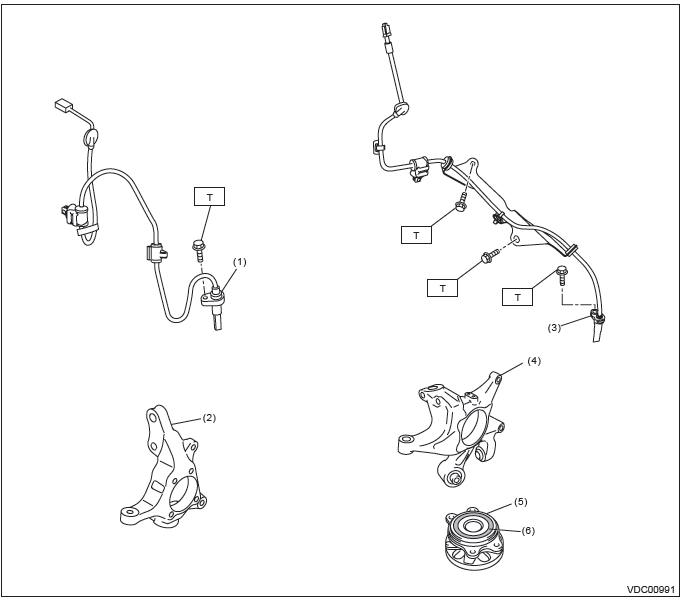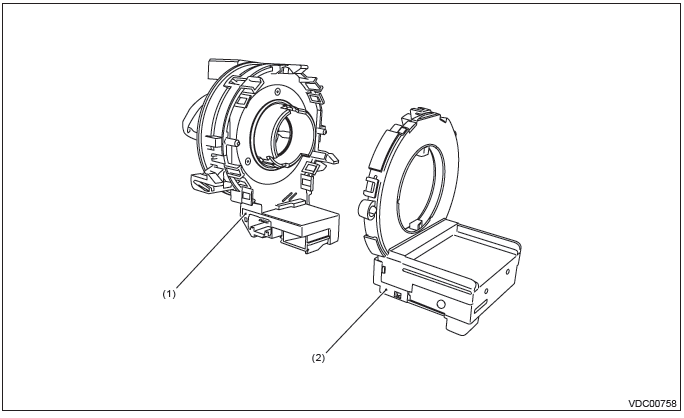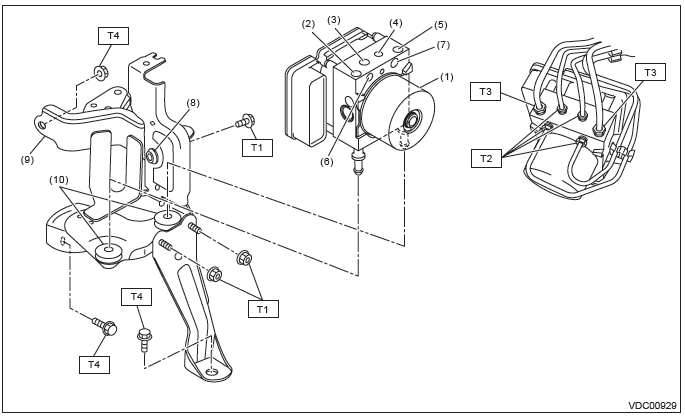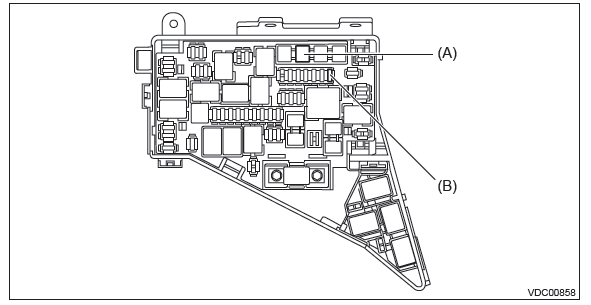Subaru Outback (BR): General Description of Vehicle Dynamics Control
A: SPECIFICATION

B: COMPONENT
1. ABS WHEEL SPEED SENSOR

- Front ABS wheel speed sensor
- Front axle housing
- Rear ABS wheel speed sensor
- Rear axle housing
- Hub unit bearing
- Magnetic encoder
Tightening torque:N*m (kgf-m, ft-lb)
T: 7.5 (0.76, 5.5)
2. STEERING ANGLE SENSOR

- Steering roll connector
- Steering angle sensor
3. VDC CONTROL MODULE & HYDRAULIC CONTROL UNIT (VDCCM&H/U)

- VDC control module and hydraulic control unit (VDCCM&H/U)
- Secondary inlet
- Front LH outlet
- Front RH outlet
- Primary inlet
- Rear RH outlet
- Rear LH outlet
- Damper & spacer
- Bracket
- Damper
Tightening torque:N*m (kgf-m, ft-lb)
T1: 7.5 (0.76, 5.5)
T2: 15 (1.53, 11.1)
T3: 19 (1.94, 14.0)
T4: 33 (3.36, 24.3)
C: CAUTION
- Wear appropriate work clothing, including a helmet, protective goggles and protective shoes when performing any work.
- Remove contamination including dirt and corrosion before removal, installation or disassembly.
- Keep the disassembled parts in order and protect them from dust and dirt.
- Before disconnecting connectors of sensors or units, be sure to disconnect the ground cable from battery.
- Before removal, installation or disassembly, be sure to clarify the failure. Avoid unnecessary removal, installation, disassembly and replacement.
- Vehicle components are extremely hot after driving. Be wary of receiving burns from heated parts.
- Be sure to tighten fasteners including bolts and nuts to the specified torque.
- Place shop jacks or rigid racks at the specified points.
D: PREPARATION TOOL
1. SPECIAL TOOL

2. GENERAL TOOL

Relay and Fuse
A: LOCATION


NOTE: For other related fuses, refer to the wiring diagram. <Ref. to WI-15, Power Supply Circuit.>
B: INSPECTION
1. CHECK FUSE.
1) Remove the fuse and inspect visually.
2) If the fuse is blown out, replace the fuse.
Vehicle Dynamics Control System
A: WIRING DIAGRAM
Refer to "Vehicle Dynamics Control System" in the wiring diagram. <Ref. to WI-251, WIRING DIAGRAM, Vehicle Dynamics Control System.>
B: ELECTRICAL SPECIFICATION
Refer to the Control Module I/O Signal of the "Vehicle Dynamics Control System (VDC) (DIAGNOSTICS)".
<Ref. to VDC(diag)-12, ELECTRICAL SPECIFICATION, Control Module I/O Signal.>
C: INSPECTION
Refer to the "Vehicle Dynamics Control System (VDC) (DIAGNOSTICS)". <Ref. to VDC(diag)-90, INSPECTION, General Diagnostic Table.>
D: NOTE
For operation procedures of each component of the vehicle dynamics control system, refer to the respective section.
- VDC control module & hydraulic control unit (VDCCM&H/U): <Ref. to VDC-9, VDC Control Module and Hydraulic Control Unit (VDCCM&H/U).>
- Yaw rate & G sensor: <Ref. to VDC-23, Yaw Rate and G Sensor.>
- Steering angle sensor: <Ref. to VDC-24, Steering Angle Sensor.>
- Front ABS wheel speed sensor: <Ref. to VDC-29, Front ABS Wheel Speed Sensor.>
- Rear ABS wheel speed sensor: <Ref. to VDC-32, Rear ABS Wheel Speed Sensor.>
- Front magnetic encoder: <Ref. to VDC-34, Front Magnetic Encoder.>
- Rear magnetic encoder: <Ref. to VDC-35, Rear Magnetic Encoder.>
- VDC OFF switch: <Ref. to VDC-36, VDC OFF Switch.>

